light CADILLAC DEVILLE 2000 8.G Owners Manual
[x] Cancel search | Manufacturer: CADILLAC, Model Year: 2000, Model line: DEVILLE, Model: CADILLAC DEVILLE 2000 8.GPages: 385, PDF Size: 2.82 MB
Page 3 of 385
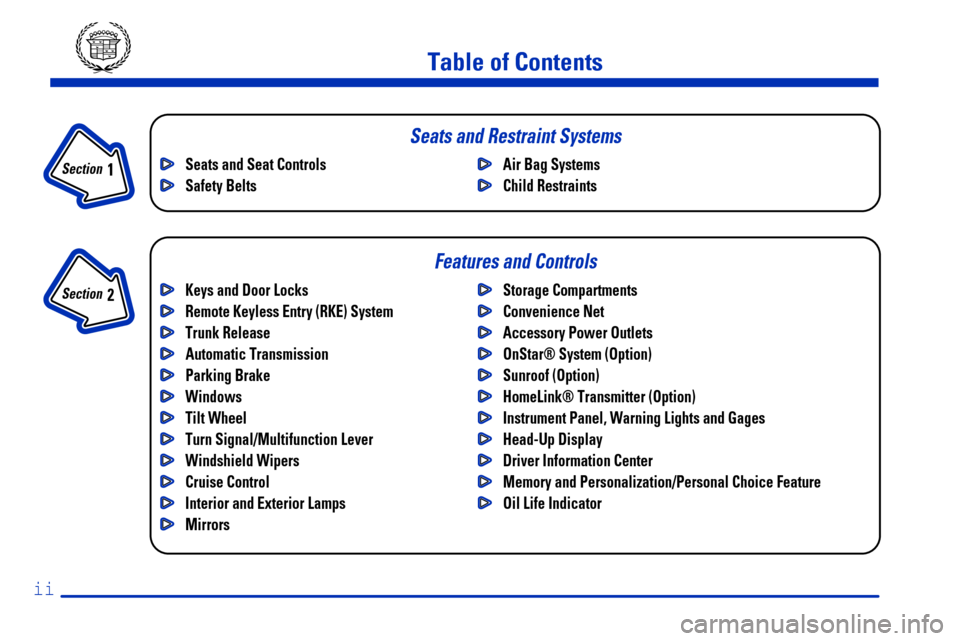
ii
Table of Contents
Keys and Door Locks
Remote Keyless Entry (RKE) System
Trunk Release
Automatic Transmission
Parking Brake
Windows
Tilt Wheel
Turn Signal/Multifunction Lever
Windshield Wipers
Cruise Control
Interior and Exterior Lamps
MirrorsStorage Compartments
Convenience Net
Accessory Power Outlets
OnStar® System (Option)
Sunroof (Option)
HomeLink® Transmitter (Option)
Instrument Panel, Warning Lights and Gages
Head-Up Display
Driver Information Center
Memory and Personalization/Personal Choice Feature
Oil Life Indicator Seats and Seat Controls
Safety BeltsAir Bag Systems
Child Restraints
Section
1
Section
2
Seats and Restraint Systems
Features and Controls
Page 10 of 385

ix
For example,
these symbols
are used on an
original battery:
CAUTION
POSSIBLE
INJURY
PROTECT
EYES BY
SHIELDING
CAUSTIC
BATTERY
ACID COULD
CAUSE
BURNS
AVOID
SPARKS OR
FLAMES
SPARK OR
FLAME
COULD
EXPLODE
BATTERY
These symbols
are important
for you and
your passengers
whenever your
vehicle is
driven:
DOOR LOCK
UNLOCK
FASTEN
SEAT
BELTS
POWER
WINDOW
AIR BAG
These symbols
have to do with
your lamps:
MASTER
LIGHTING
SWITCH
TURN
SIGNALS
PARKING
LAMPS
HAZARD
WARNING
FLASHER
DAYTIME
RUNNING
LAMPS
FOG LAMPS
These symbols
are on some of
your controls:
WINDSHIELD
WIPER
WINDSHIELD
WASHER
WINDSHIELD
DEFROSTER
REAR
WINDOW
DEFOGGER
VENTILATING
FAN
These symbols
are used on
warning and
indicator lights:
ENGINE
COOLANT
TEMP
BATTERY
CHARGING
SYSTEM
BRAKE
COOLANT
ENGINE OIL
PRESSURE
ANTI-LOCK
BRAKES
Here are some
other symbols
you may see:
FUSE
LIGHTER
HORN
SPEAKER
FUEL
Vehicle Symbols
These are some of the symbols you may find on your vehicle.
Page 17 of 385
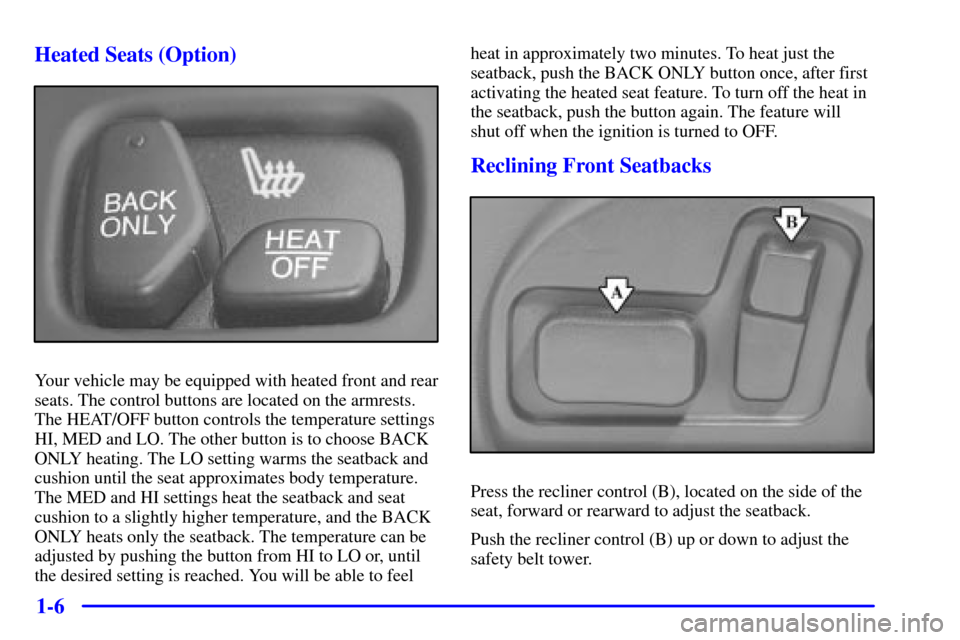
1-6 Heated Seats (Option)
Your vehicle may be equipped with heated front and rear
seats. The control buttons are located on the armrests.
The HEAT/OFF button controls the temperature settings
HI, MED and LO. The other button is to choose BACK
ONLY heating. The LO setting warms the seatback and
cushion until the seat approximates body temperature.
The MED and HI settings heat the seatback and seat
cushion to a slightly higher temperature, and the BACK
ONLY heats only the seatback. The temperature can be
adjusted by pushing the button from HI to LO or, until
the desired setting is reached. You will be able to feelheat in approximately two minutes. To heat just the
seatback, push the BACK ONLY button once, after first
activating the heated seat feature. To turn off the heat in
the seatback, push the button again. The feature will
shut off when the ignition is turned to OFF.
Reclining Front Seatbacks
Press the recliner control (B), located on the side of the
seat, forward or rearward to adjust the seatback.
Push the recliner control (B) up or down to adjust the
safety belt tower.
Page 20 of 385

1-9
CAUTION:
It is extremely dangerous to ride in a cargo area,
inside or outside of a vehicle. In a collision,
people riding in these areas are more likely to be
seriously injured or killed. Do not allow people to
ride in any area of your vehicle that is not
equipped with seats and safety belts. Be sure
everyone in your vehicle is in a seat and using a
safety belt properly.
Your vehicle has a light that
comes on as a reminder to
buckle up. (See ªSafety Belt
Reminder Lightº in
the Index.)
In most states and Canadian provinces, the law says to
wear safety belts. Here's why: They work.
You never know if you'll be in a crash. If you do have a
crash, you don't know if it will be a bad one.
A few crashes are mild, and some crashes can be so
serious that even buckled up a person wouldn't survive.
But most crashes are in between. In many of them,
people who buckle up can survive and sometimes walk
away. Without belts they could have been badly hurt
or killed.
After more than 30 years of safety belts in vehicles,
the facts are clear. In most crashes buckling up does
matter ... a lot!
Page 25 of 385
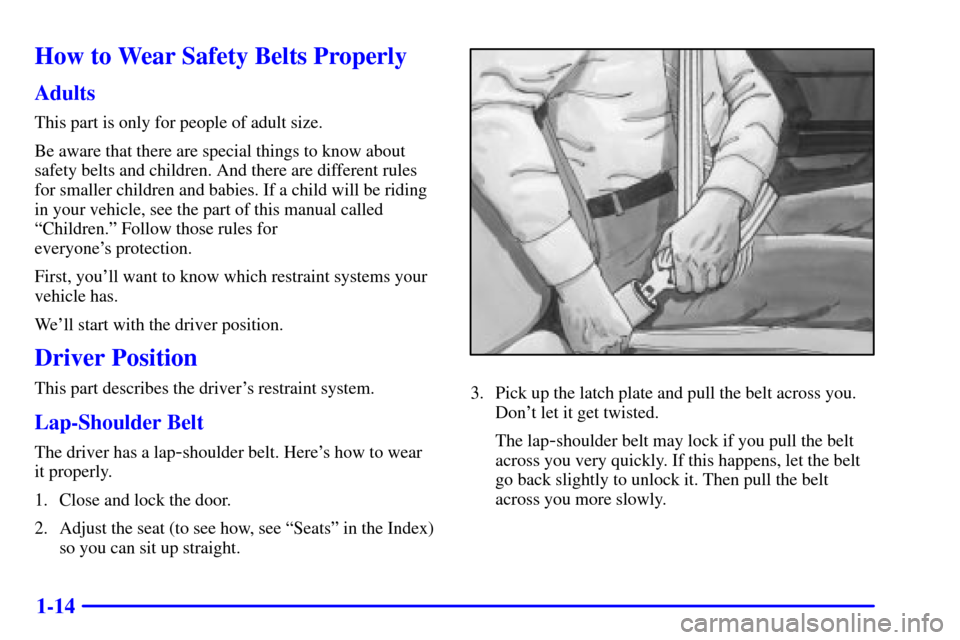
1-14
How to Wear Safety Belts Properly
Adults
This part is only for people of adult size.
Be aware that there are special things to know about
safety belts and children. And there are different rules
for smaller children and babies. If a child will be riding
in your vehicle, see the part of this manual called
ªChildren.º Follow those rules for
everyone's protection.
First, you'll want to know which restraint systems your
vehicle has.
We'll start with the driver position.
Driver Position
This part describes the driver's restraint system.
Lap-Shoulder Belt
The driver has a lap-shoulder belt. Here's how to wear
it properly.
1. Close and lock the door.
2. Adjust the seat (to see how, see ªSeatsº in the Index)
so you can sit up straight.
3. Pick up the latch plate and pull the belt across you.
Don't let it get twisted.
The lap
-shoulder belt may lock if you pull the belt
across you very quickly. If this happens, let the belt
go back slightly to unlock it. Then pull the belt
across you more slowly.
Page 28 of 385
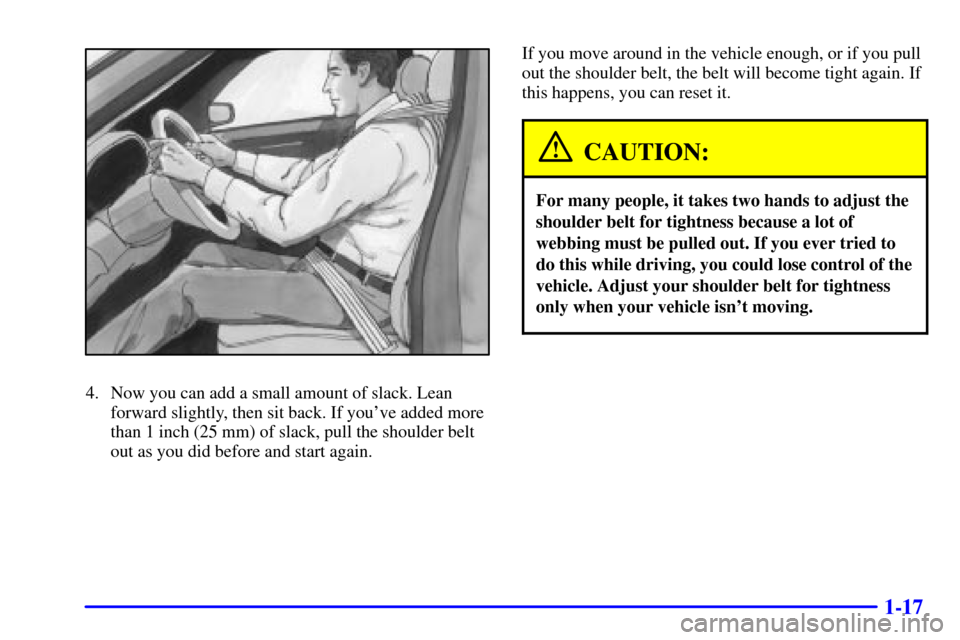
1-17
4. Now you can add a small amount of slack. Lean
forward slightly, then sit back. If you've added more
than 1 inch (25 mm) of slack, pull the shoulder belt
out as you did before and start again.If you move around in the vehicle enough, or if you pull
out the shoulder belt, the belt will become tight again. If
this happens, you can reset it.
CAUTION:
For many people, it takes two hands to adjust the
shoulder belt for tightness because a lot of
webbing must be pulled out. If you ever tried to
do this while driving, you could lose control of the
vehicle. Adjust your shoulder belt for tightness
only when your vehicle isn't moving.
Page 37 of 385
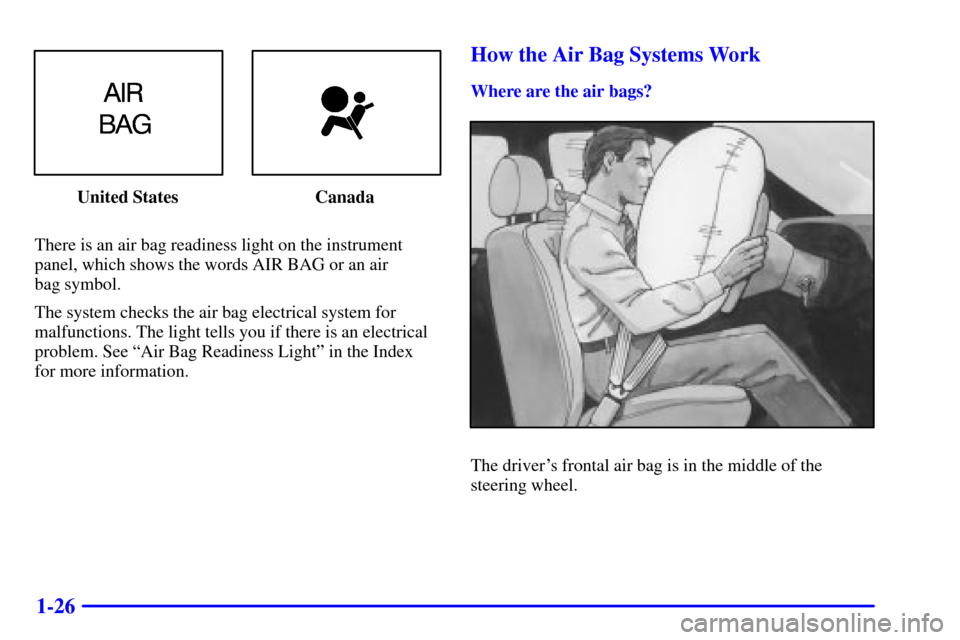
1-26
United States Canada
There is an air bag readiness light on the instrument
panel, which shows the words AIR BAG or an air
bag symbol.
The system checks the air bag electrical system for
malfunctions. The light tells you if there is an electrical
problem. See ªAir Bag Readiness Lightº in the Index
for more information.
How the Air Bag Systems Work
Where are the air bags?
The driver's frontal air bag is in the middle of the
steering wheel.
Page 46 of 385
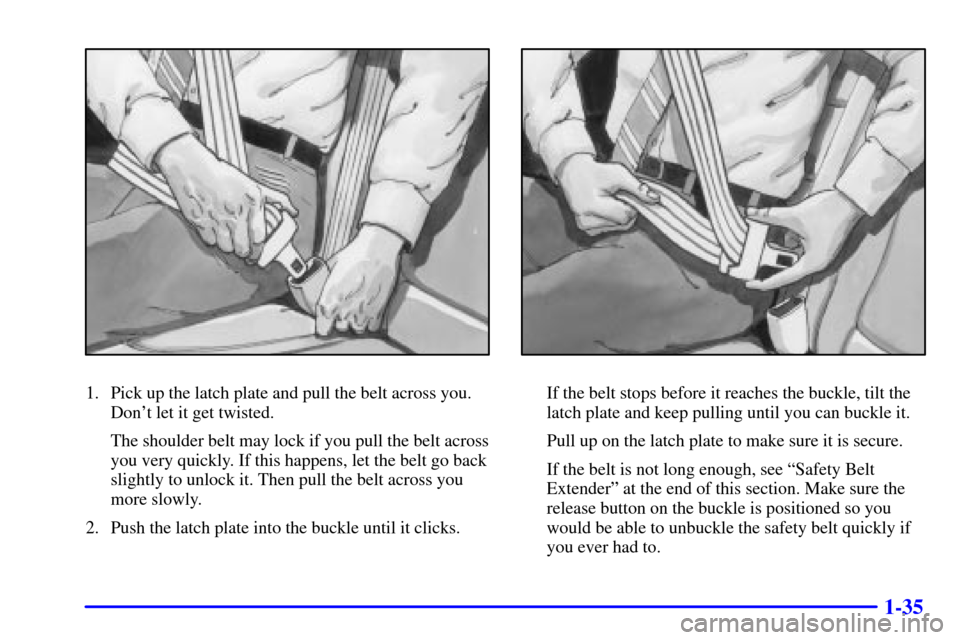
1-35
1. Pick up the latch plate and pull the belt across you.
Don't let it get twisted.
The shoulder belt may lock if you pull the belt across
you very quickly. If this happens, let the belt go back
slightly to unlock it. Then pull the belt across you
more slowly.
2. Push the latch plate into the buckle until it clicks.If the belt stops before it reaches the buckle, tilt the
latch plate and keep pulling until you can buckle it.
Pull up on the latch plate to make sure it is secure.
If the belt is not long enough, see ªSafety Belt
Extenderº at the end of this section. Make sure the
release button on the buckle is positioned so you
would be able to unbuckle the safety belt quickly if
you ever had to.
Page 48 of 385

1-37
The safety belt locks if there's a sudden stop or a crash,
or if you pull the belt very quickly out of the retractor.
The rear outboard seating positions may have a shoulder
belt tightness adjustment feature. You can tell if your
vehicle has this feature by following the steps below. If
you can add a small amount of slack, your vehicle has
this feature.
If the shoulder belt seems too tight:
1. Sit well back in the seat.
2. Pull the shoulder belt all the way out of the retractor.
3. Let belt go back all the way.
4. Now you can add a small amount of slack. Lean
forward slightly, then sit back. If you've added more
than 1 inch (25 mm) of slack, pull the shoulder belt
out as you did before and start again.
If you move around in the vehicle enough or if you pull
out the shoulder belt, the belt will become tight again. If
this happens, you can reset it.
Page 69 of 385

1-58
Safety Belt Extender
If the vehicle's safety belt will fasten around you, you
should use it.
But if a safety belt isn't long enough to fasten, your
dealer will order you an extender. It's free. When you go
in to order it, take the heaviest coat you will wear, so the
extender will be long enough for you. The extender will
be just for you, and just for the seat in your vehicle that
you choose. Don't let someone else use it, and use it
only for the seat it is made to fit. To wear it, just attach it
to the regular safety belt.
Checking Your Restraint Systems
Now and then, make sure the safety belt reminder light
and all your belts, buckles, latch plates, retractors and
anchorages are working properly. Look for any other
loose or damaged safety belt system parts. If you see
anything that might keep a safety belt system from
doing its job, have it repaired.
Torn or frayed safety belts may not protect you in a
crash. They can rip apart under impact forces. If a belt is
torn or frayed, get a new one right away.
Also look for any opened or broken air bag covers, and
have them repaired or replaced. (The air bag system
does not need regular maintenance.)
Replacing Restraint System Parts
After a Crash
If you've had a crash, do you need new belts?
After a very minor collision, nothing may be necessary.
But if the belts were stretched, as they would be if worn
during a more severe crash, then you need new belts.
If belts are cut or damaged, replace them. Collision
damage also may mean you will need to have safety belt
or seat parts repaired or replaced. New parts and repairs
may be necessary even if the belt wasn't being used at
the time of the collision.
If an air bag inflates, you'll need to replace air bag
system parts. See the part on the air bag system earlier in
this section.
If the frontal air bags inflate, you'll also need to replace
the driver's and right front passenger's safety belt
buckle assembly. Be sure to do so. Then the new buckle
assembly will be there to help protect you in a collision.